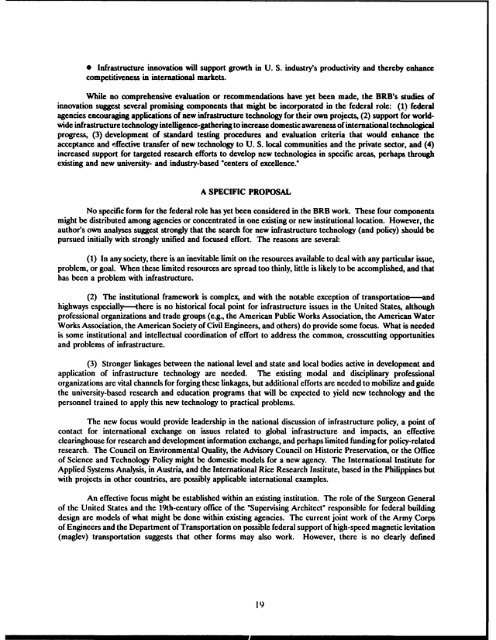Challenges and Opportunities for Innovation in the Public Works ...
Challenges and Opportunities for Innovation in the Public Works ...
Challenges and Opportunities for Innovation in the Public Works ...
Create successful ePaper yourself
Turn your PDF publications into a flip-book with our unique Google optimized e-Paper software.
0 Infrastructure <strong>in</strong>novation will support growth <strong>in</strong> U. S. <strong>in</strong>dustry's productivity <strong>and</strong> <strong>the</strong>reby enhance<br />
competitiveness <strong>in</strong> <strong>in</strong>ternational markets.<br />
While no comprehensive evaluation or recommendations have yet been made, <strong>the</strong> BRB's studies of<br />
<strong>in</strong>novation suggest several promis<strong>in</strong>g components that might be <strong>in</strong>corporated <strong>in</strong> <strong>the</strong> federal role: (1) federal<br />
agencies encourag<strong>in</strong>g applications of new <strong>in</strong>frastructure technology <strong>for</strong> <strong>the</strong>ir own projects, (2) support <strong>for</strong> worldwide<br />
<strong>in</strong>frastructure technology <strong>in</strong>telligence-ga<strong>the</strong>r<strong>in</strong>g to <strong>in</strong>crease domestic awareness of <strong>in</strong>ternational technological<br />
progress, (3) development of st<strong>and</strong>ard test<strong>in</strong>g procedures <strong>and</strong> evaluation criteria that would enhance <strong>the</strong><br />
acceptance <strong>and</strong> effective transfer of new technology to U. S. local communities <strong>and</strong> <strong>the</strong> private sector, <strong>and</strong> (4)<br />
<strong>in</strong>creased support <strong>for</strong> targeted research ef<strong>for</strong>ts to develop new technologies <strong>in</strong> specific areas, perhaps through<br />
exist<strong>in</strong>g <strong>and</strong> new university- <strong>and</strong> <strong>in</strong>dustry-based "centers of excellence."<br />
A SPECIFIC PROPOSAL<br />
No specific <strong>for</strong>m <strong>for</strong> <strong>the</strong> federal role has yet been considered <strong>in</strong> <strong>the</strong> BRB work. These four components<br />
might be distributed among agencies or concentrated <strong>in</strong> one exist<strong>in</strong>g or new <strong>in</strong>stitutional location. However, <strong>the</strong><br />
author's own analyses suggest strongly that <strong>the</strong> search <strong>for</strong> new <strong>in</strong>frastructure technology (<strong>and</strong> policy) should be<br />
pursued <strong>in</strong>itially with strongly unified <strong>and</strong> focused ef<strong>for</strong>t. The reasons are several:<br />
(1) In any society, <strong>the</strong>re is an <strong>in</strong>evitable limit on <strong>the</strong> resources available to deal with any particular issue,<br />
problem, or goal. When <strong>the</strong>se limited resources are spread too th<strong>in</strong>ly, little is likely to be accomplished, <strong>and</strong> that<br />
has been a problem with <strong>in</strong>frastructure.<br />
(2) The <strong>in</strong>stitutional framework is complex, <strong>and</strong> with <strong>the</strong> notable exception of transportation---<strong>and</strong><br />
highways especially---<strong>the</strong>re is no historical focal po<strong>in</strong>t <strong>for</strong> <strong>in</strong>frastructure issues <strong>in</strong> <strong>the</strong> United States, although<br />
professional organizations <strong>and</strong> trade groups (e.g., <strong>the</strong> American <strong>Public</strong> <strong>Works</strong> Association, <strong>the</strong> American Water<br />
<strong>Works</strong> Association, <strong>the</strong> American Society of Civil Eng<strong>in</strong>eers, <strong>and</strong> o<strong>the</strong>rs) do provide some focus. What is needed<br />
is some <strong>in</strong>stitutional <strong>and</strong> <strong>in</strong>tellectual coord<strong>in</strong>ation of ef<strong>for</strong>t to address <strong>the</strong> common, crosscutt<strong>in</strong>g opportunities<br />
<strong>and</strong> problems of <strong>in</strong>frastructure.<br />
(3) Stronger l<strong>in</strong>kages between <strong>the</strong> national level <strong>and</strong> state <strong>and</strong> local bodies active <strong>in</strong> development <strong>and</strong><br />
application of <strong>in</strong>frastructure technology are needed. The exist<strong>in</strong>g modal <strong>and</strong> discipl<strong>in</strong>ary professional<br />
organizations are vital channels <strong>for</strong> <strong>for</strong>g<strong>in</strong>g <strong>the</strong>se l<strong>in</strong>kages, but additional ef<strong>for</strong>ts are needed to mobilize <strong>and</strong> guide<br />
<strong>the</strong> university-based research <strong>and</strong> education programs that will be expected to yield new technology <strong>and</strong> <strong>the</strong><br />
personnel tra<strong>in</strong>ed to apply this new technology to practical problems.<br />
The new focus would provide leadership <strong>in</strong> <strong>the</strong> national discussion of <strong>in</strong>frastructure policy, a po<strong>in</strong>t of<br />
contact <strong>for</strong> <strong>in</strong>ternational exchange on issues related to global <strong>in</strong>frastructure <strong>and</strong> impacts, an effective<br />
clear<strong>in</strong>ghouse <strong>for</strong> research <strong>and</strong> development <strong>in</strong><strong>for</strong>mation exchange, <strong>and</strong> perhaps limited fund<strong>in</strong>g <strong>for</strong> policy-related<br />
research. The Council on Environmental Quality, <strong>the</strong> Advisory Council on Historic Preservation, or <strong>the</strong> Office<br />
of Science <strong>and</strong> Technology Policy might be domestic models <strong>for</strong> a new agency. The International Institute <strong>for</strong><br />
Applied Systems Analysis, <strong>in</strong> Austria, <strong>and</strong> <strong>the</strong> International Rice Research Institute, based <strong>in</strong> <strong>the</strong> Philipp<strong>in</strong>es but<br />
with projects <strong>in</strong> o<strong>the</strong>r countries, are possibly applicable <strong>in</strong>ternational examples.<br />
An effective focus might be established with<strong>in</strong> an exist<strong>in</strong>g <strong>in</strong>stitution. The role of <strong>the</strong> Surgeon General<br />
of <strong>the</strong> United States <strong>and</strong> <strong>the</strong> 19th-century office of <strong>the</strong> "Supervis<strong>in</strong>g Architect" responsible <strong>for</strong> federal build<strong>in</strong>g<br />
design are models of what might be done with<strong>in</strong> exist<strong>in</strong>g agencies. The current jo<strong>in</strong>t work of <strong>the</strong> Army Corps<br />
of Eng<strong>in</strong>eers <strong>and</strong> <strong>the</strong> Department of Transportation on possible federal support of high-speed magnetic levitation<br />
(maglev) transportation suggests that o<strong>the</strong>r <strong>for</strong>ms may also work. However, <strong>the</strong>re is no clearly def<strong>in</strong>ed<br />
19







